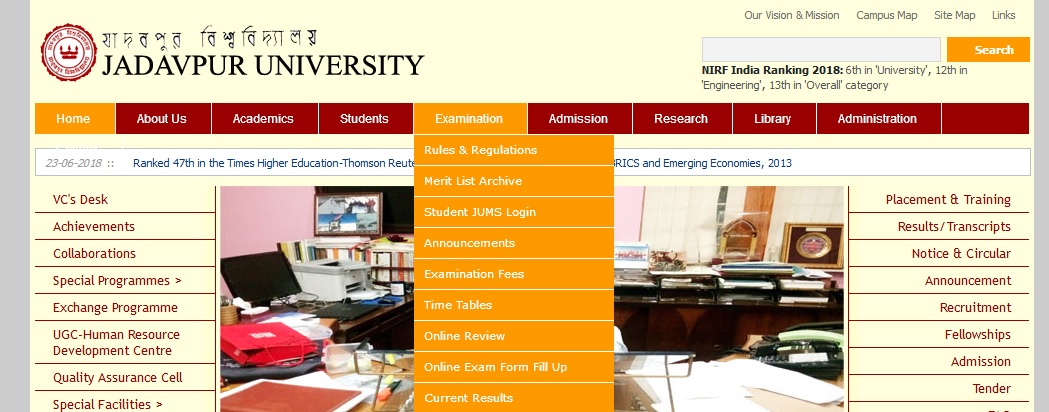Physico Chemical Processing of Materials M.Tech Question Paper : jaduniv.edu.in
Name of the University : Jadavpur University
Department : Material Engineering
Degree : M.Tech
Subject Name : Physico Chemical Processing Of Materials
Sem : I
Website : jaduniv.edu.in
Document Type : Model Question Paper
Download Model/Sample Question Paper : https://www.pdfquestion.in/uploads/dspace.jdvu.ac.in/5491-PHYSICO%20CHEMICAL%20PROCESSING%20OF%20MATERIALS_Seme1_2004.pdf
Jadavpur Chemical Processing Of Materials Question Paper
M. TECH. Material Engg. Examination, 2004 :
( 1st Semester )
Time : Three hours
Full Marks : 100 (50 marks for each part)
Use a separate answer-script for each part
Related : Jadavpur University Polymeric Materials M.Tech Question Paper Model : www.pdfquestion.in/5481.html
PART I
Answer question 1 and any two from the rest. :
1. a) Compare efficiciency of separation between dry and wet magnetic separation.
b) How can you decrease the entrapment of non-magnetic particle in magnetic fraction ?
c) What is ideal contact angle for flotation ? Explain.
d) Is crushing efficiency increased by increasing the speed of rotation of grinding mill ?
e) What is liberation of minerals ? How it plays during separation technique ? 2×5

2. a) Explain the principle of oxidising roasting with an example. 10
b) Explain the role of chlorination roasting of ilmenite. How can you decrease the contamination level of iron ? 10
3. a) What is segregation roasting ? Explain the various reactions involved in popper segregation from sulphide concentrate. 10
b) Give one industrial application of reduction roasting with process details. 10
4. a) What is matte smelting ? How can you produce copper matte from Ore? Discuss. 10
b) Explain the role of vacuum in Mg extraction using metallothermic smelting ? 10
PART II
Answer question number 5 and any two frem the rest. :
5. Derive expression for the following properties. 5+5
a) in terms of Cp, a,ß, V, T
b) in terms of Cp, a,ß, V, T.
6. a) Deduce Gibbs-Helmholtz Equation. 8
b) What is Jule-Thomson effect ? What is inversion temperature? Deduce relationship between Jule-Thomson co-efficient and temperature for a vandar walls gas. 2+2+8
7 a) Discuss in details the thermodynamics of oxidation of metals and dissociation of of metal oxides. 10
b) Deduce the equation for the thermodynamic potential for oxidation reaction of moltenmetal at temperature T. 10
8. a) Establish the relationship between vapour pressure and the quantity of vapour of a substance. 8
b) Describe the vacuum distillation technique for the seperation of zinc from brass scrap with the help of suiable diagrams 12
9. a) What is rectification refining ? Under what conditions the rectification refining is done? 2+6
b) Describe the rectification refining technique of any one of the following 12
i ) Seperation of Zinc from cadmium.
ii) Seperation of Zinc from Lead.
Syllabus
Metallurgical & Material Engineering :
The department. of Metallurgical Engineering was established in 1956 with the purpose of imparting excellent training to students who would be able to join several industries as qualified engineers, dealing with the production and processing of metals and alloys including foundries, rolling mills and fabrication shops. The focus of post graduate degree is mainly fixed to train qualified metallurgical engineers for state of art technologies at different Indian metallurgical industries.
Research Activities :
** Phase Transformation in Metals
** Fatigue and Fracture of Metals and Materials
** Corrosion Behavior
** Protection against Corrosion of Metals and Materials
** Stress Corrosion Cracking
** Corrosion Fatigue Behavior of Heat Treated and Welded Specimens
** Process Metallurgy and Kinetic Behavior of Metallurgical Processes
** Bioleaching of Minerals
** Preparation and Characterization of Glass and Nanocomposites
** Surface Engineering
** Non-destructive Evaluation for Assessment of Fatigue Damage
** Joining of Materials
** Upgradation of low grade ore and subsequent metal exhaction
** Foundry Design